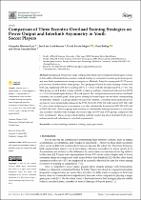Por favor, use este identificador para citar o enlazar este ítem:
https://repositorio.usj.es/handle/123456789/685
Registro completo de metadatos
| Campo DC | Valor | Lengua/Idioma |
|---|---|---|
| dc.contributor.author | Moreno-Azze, Alejandro | - |
| dc.contributor.author | Arjol-Serrano, José Luis | - |
| dc.contributor.author | Falcon-Miguel, David | - |
| dc.contributor.author | Bishop, Chris John | - |
| dc.contributor.author | Gonzalo-Skok, Óliver | - |
| dc.date.accessioned | 2021-11-16T10:42:17Z | - |
| dc.date.available | 2021-11-16T10:42:17Z | - |
| dc.date.issued | 2021-08 | - |
| dc.identifier.citation | Moreno-Azze, A.; Arjol-Serrano, J.L.; Falcón-Miguel, D.; Bishop, C.; Gonzalo-Skok, O. Comparison of Three Eccentric Overload Training Strategies on Power Output and Interlimb Asymmetry in Youth Soccer Players. Int. J. Environ. Res. Public Health 2021, 18, 8270. https://doi.org/10.3390/ ijerph18168270 | es_ES |
| dc.identifier.issn | 1660-4601 | es_ES |
| dc.identifier.uri | https://repositorio.usj.es/handle/123456789/685 | - |
| dc.description.abstract | Background: The present study compared the effects of performing the lateral squat exercise in three different formats from eccentric overload training on concentric/eccentric peak/mean power and inter-limb asymmetries in young soccer players. Methods: Forty-five young male (U-17) soccer players were distributed into three groups. Two groups performed the same training volume with both legs, beginning with the weaker leg (SVW, n = 15) or with the stronger leg (SVS, n = 15). The third group executed double volume with the weaker leg and also commenced with such leg (DVW, n = 15) in the lateral squat during a 10-week period. Pre- and post-intervention metrics included concentric and eccentric peak/mean power during the lateral squat test and their corresponding asymmetries. Results: All groups improved all power variables. Concentric mean and peak power asymmetry were substantially reduced in the SVW (ES: 0.89), DVW (ES: 0.43), and in SVW (ES: 1.60). Eccentric mean and peak power asymmetry were also substantially decreased in SVW (ES: 0.81) and in DVW (ES: 0.68). Between-group analyses showed substantially better performance in concentric and eccentric variables with stronger and weaker legs in SVW and DVW groups compared with SVS. Conclusions: Those groups which started with the weaker leg showed greater both power enhancements and reductions on inter-limb asymmetries. | es_ES |
| dc.format.extent | 12 p. | es_ES |
| dc.format.mimetype | application/pdf | es_ES |
| dc.language.iso | eng | es_ES |
| dc.publisher | MDPI | es_ES |
| dc.rights | Atribución 4.0 Internacional | * |
| dc.rights.uri | http://creativecommons.org/licenses/by/4.0/ | * |
| dc.subject | Eccentric training | es_ES |
| dc.subject | Resistance training | es_ES |
| dc.subject | Injury prevention | es_ES |
| dc.title | Comparison of Three Eccentric Overload Training Strategies on Power Output and Interlimb Asymmetry in Youth Soccer Players | es_ES |
| dc.type | info:eu-repo/semantics/article | es_ES |
| dc.identifier.doi | https://doi.org/10.3390/ijerph18168270 | es_ES |
| dc.rights.accessrights | info:eu-repo/semantics/openAccess | es_ES |
| Aparece en las colecciones: | Artículos de revistas | |
Ficheros en este ítem:
| Fichero | Descripción | Tamaño | Formato | |
|---|---|---|---|---|
| Comparison of Three Eccentric Overload Training.pdf | 1,79 MB | Adobe PDF |  Visualizar/Abrir |
Este ítem está sujeto a una licencia Creative Commons Licencia Creative Commons

